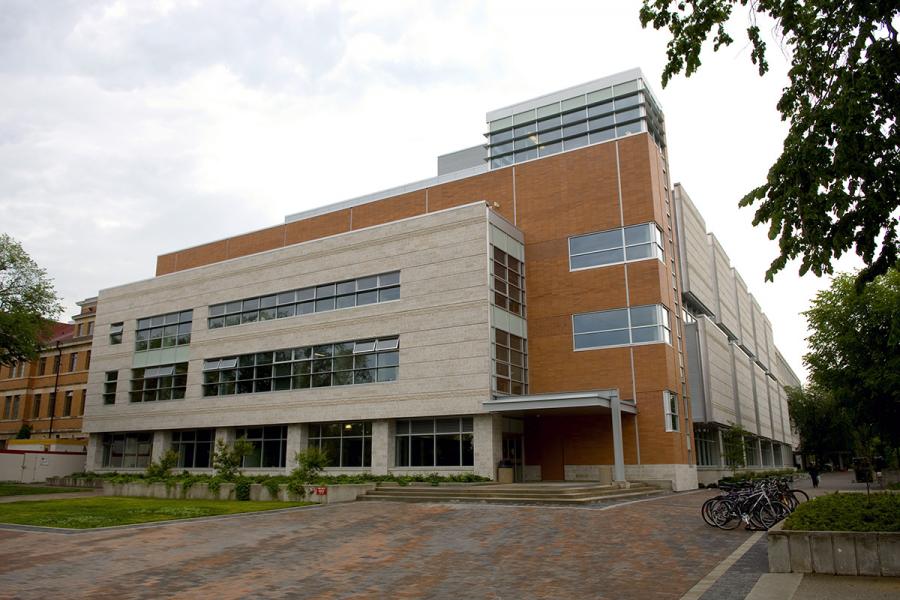Professor
Department of Biosystems Engineering
Room W579
Duff Roblin Building
University of Manitoba (Fort Garry campus)
Winnipeg, MB R3T 5V6
The University of Manitoba campuses and research spaces are located on original lands of Anishinaabeg, Ininiwak, Anisininewuk, Dakota Oyate, Dene and Inuit, and on the National Homeland of the Red River Métis. More
University of Manitoba
Winnipeg, Manitoba Canada, R3T 2N2

Professor
Department of Biosystems Engineering
Room W579
Duff Roblin Building
University of Manitoba (Fort Garry campus)
Winnipeg, MB R3T 5V6
Biomaterials, nanofibers, hydrogels, soft materials.
Dr. Wen Zhong has been focusing on the application of nanotechnology in biomaterials since she joined the University of Manitoba in 2005. Specifically, she conducts research on 1) multifunctional nanofibers for wound care and tissue engineering; 2) multifunctional hydrogels for biosensors; 3) nano-carriers for therapeutic agents; 4) Transport in nanofibrous materials. Her research has been support by NSERC and CFI.
Dr. Zhong is currently seeking students with MSc (BS if applying for MS program) in Material Science/Engineering/ (bio)chemistry /biomedical or related disciplines. Interest and/or experience in one or more of the following areas:
Hydrogels, nanofibrous materials, targeted drug delivery, biodegradable membrane/structures.
Contact Dr. Wen Zhong with CV, research statement, sample publications, names and contact of three references.
1. Y Liu, Y Li, H Shang, W Zhong, Q Wang, K Mequanint, C Zhu, M Xing, H Wei. (2022). Underwater instant adhesion mechanism of self-assembled amphiphilic hemostatic granular hydrogel from Andrias davidianus skin secretion. Iscience. 25(10): 05106
2. Y Liu, G Guan, Y Li, J Tan, P Cheng, M Yang, B Li, Q Wang, W Zhong, K Mequanint, C Zhu, M Xing (2022). Gelation of highly entangled hydrophobic macromolecular fluid for ultrastrong underwater in situ fast tissue adhesion. SCIENCEADVANCES. 8(20).
3. H Hsu, X Zhang, Y Wang, K Xu, M Xing, W Zhong. (2021). Self-powered and plant wearable e-skin as light fertilizer and sensor promoting and monitoring growth in smart farming and plant-device interaction. Chemical Engineering Journal, 129499.
4. P Yu and W Zhong. (2021). Hemostatic Materials in Wound Care. Burns and Trauma. 9: tkab019.
5. Y Guo, Y Wang, X Zhao, X Li, Q Wang, W Zhong, K Mequanint, R Zhan, M Xing, G Luo. (2021). Snake extract–laden hemostatic bioadhesive gel cross-linked by visible light. Science Advances, 7(29): eabf9635.
6. S Chen, Y Liu, Y Wang, K Xu, X Zhang, W Zhong, G Luo and M Xing. (2021). Dual-functional superwettable nano-structured membrane: from ultra-effective separation of oil-water emulsion to seawater desalination. Chemical Engineering Journal, 411, 128042.
7. L Yang, Y Miao, Y Liu, S Chen, Y Chen, W Liu, J Wang, W Zhong, Q Wang, Z Hu and M Xing (2021). Regenerating hair in programable prevascularized collagen membrane formed by a controllable in-situ foreign body reaction, Advanced Functional Materials, 31, 2007483
8. I Yousefi and W Zhong. (2021). A Review of Recent Developments in Nanocellulose-Based Conductive Hydrogels. Current Nanomedicine. 17(4): 620-633.
9. H Hsu, Y Liu, Y Wang, B Li, G Luo, M Xing, W Zhong. (2020). Mussel-Inspired Autonomously Self-Healable All-in-One Supercapacitor with Biocompatible Hydrogel. ACS Sustainable Chemistry & Engineering, 8(18): 6935-6948.
10. Q Chang, Y He, Y Liu, W Zhong, Q Wang, F Lu and M Xing. (2020). Protein Gel Phase Transition: Toward Superiorly Transparent and Hysteresis‐Free Wearable Electronics. Advanced Functional Materials, 30(27): 1910080.
11. N Huang, L Liu, Y Fang, S Zheng, J Wu, M Wang, W Zhong, M Shi, M Xing and W Liao. (2020). Gold Nanoparticles Induce Tumor Vessel Normalization and Impair Metastasis by Inhibiting Endothelial Smad2/3 Signalling. ACS Nano, 14 (7): 7940–7958.
12. Y He, S Derakhshanfar, W Zhong, B Li, F Lu, M Xing, X Li. (2020) Characterization and Application of Carboxymethyl Chitosan-Based Bioink in Cartilage Tissue Engineering, Journal of Nanomaterials, 2057097.
13. A John, W Zhong. (2019). Nanocellulose-based Hydrogels for Biomedical Applications. Current Nanoscience, 2019, 15, 1-11.
14. H Hsu, A Khosrozadeh, B Li, G Luo, M Xing, W Zhong. (2019). An Eco-friendly, Nanocellulose/RGO/in-situ Formed Polyaniline for Flexible and Free-standing Supercapacitors. ACS Sustainable Chemistry & Engineering, 2019, 7, 4766-4776.
15. H Hsu, W Zhong, Nanocellulose-Based Conductive Membranes for Free-Standing Supercapacitors: A Review. Membranes, 2019, 9 (6), 74
16. Y Wang, Q Chang, R Zhan, K Xu, Y Wang, X Zhang, B Li, G Luo, M Xing, W Zhong, Tough but self-healing and 3D printable hydrogels for E-skin, E-noses and laser controlled actuators. Journal of Materials Chemistry A, 2019, 7 (43), 24814-24829
17. Q Chang, MA Darabi, Y Liu, Y He, W Zhong, K Mequanin, B Li, F Lu, MQ Xing, Hydrogels from natural egg white with extraordinary stretchability, direct-writing 3D printability and self-healing for fabrication of electronic sensors and actuators. Journal of Materials Chemistry A, 2019, 7 (42), 24626-24640
18. L Wang, X Zhang, Y He, Y Wang, W Zhong, K Mequanint, X Qiu, M Xing. (2019). Ultralight Conductive and Elastic Aerogel for Skeletal Muscle Atrophy Regeneration. Advanced Functional Materials, 1806200.